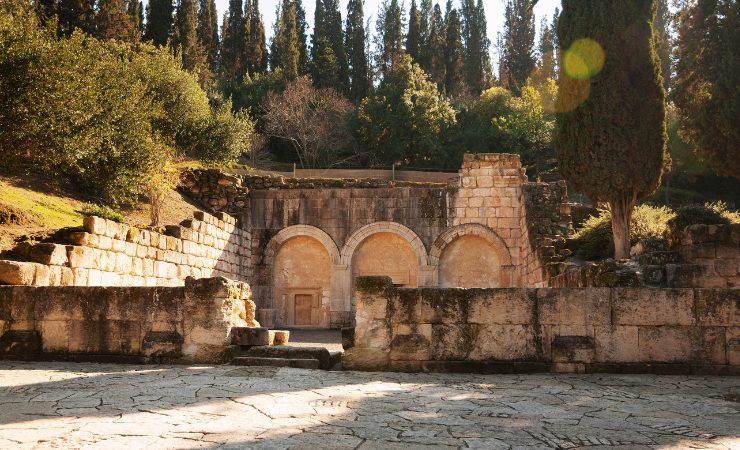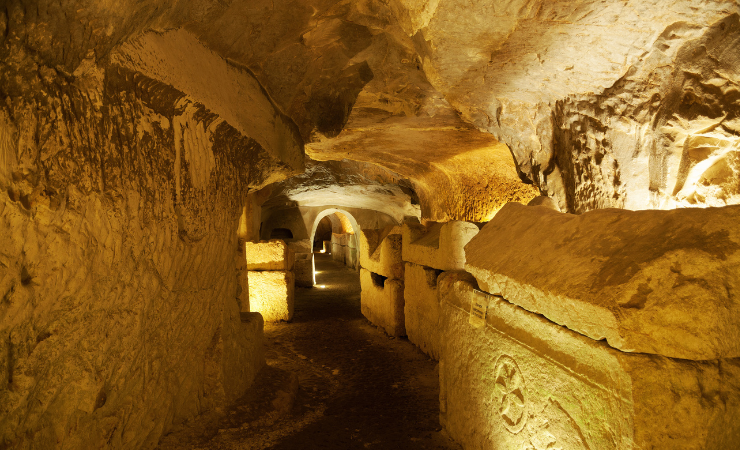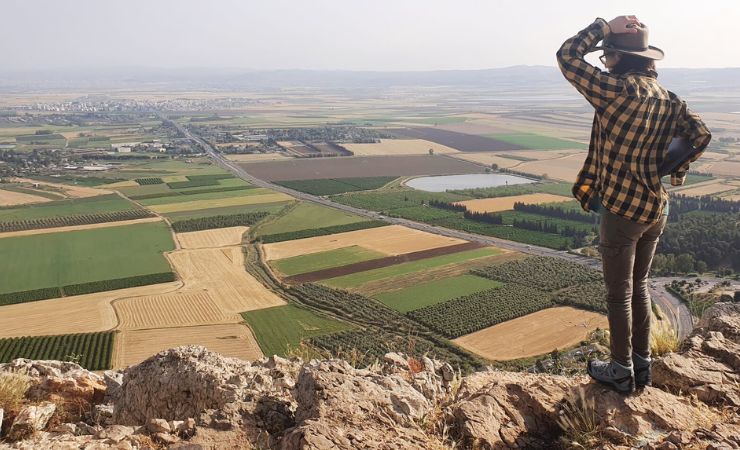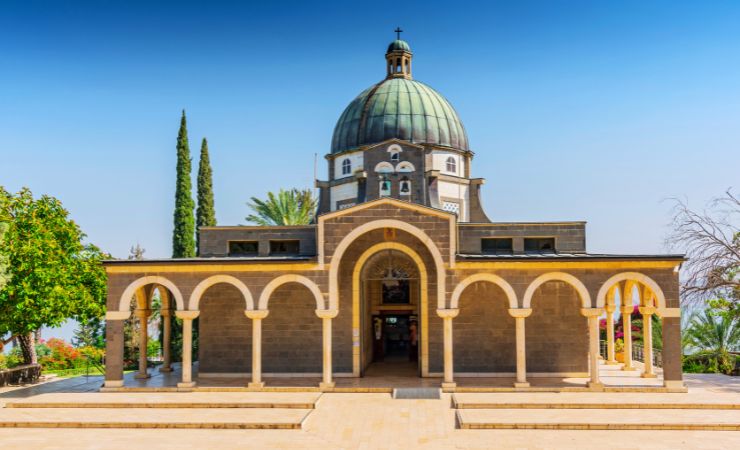Beit She'arim: A Landmark of Ancient Jewish Life and Death
Beit She’arim, located in the southern Galilee is renowned for its extensive rock-cut necropolis, and provides unparalleled insights into Jewish burial customs, artistic expressions, and is a testament to the revival and survival of ancient Judaism under the leadership of Rabbi Judah the Patriarch. The site was designated a UNESCO World Heritage Site in 2015.

Location
The ruins of the ancient town and its necropolis are situated approximately 20 kilometers east of Haifa, in the southern foothills of the Lower Galilee.



History Throughout the Ages
- Iron Age: Archaeological evidence in the form of pottery shards suggests that a first settlement existed at the site as early as the Iron Age.
- Second Temple Period: Beit She’arim was founded at the end of the 1st century BCE, during the reign of King Herod. The Roman Jewish historian Josephus Flavius mentioned the town as Besara, the administrative center of the estates of Queen Berenice in the Jezreel Valley during the 2nd century.
- Roman and Byzantine Periods: Following the destruction of the Second Temple in 70 CE, Beit She’arim became an important center of Jewish learning. The Sanhedrin, the Jewish legislature and supreme council, migrated to Beit She’arim. The town gained further prominence when Rabbi Judah Hanasi (Judah the Patriarch) took up residence there in the late 2nd century CE. The 2nd to 4th centuries CE marked the height of the town’s prosperity and the primary period of use for the necropolis. However, the quality of construction in the town declined towards the end of the third century CE, and the Sanhedrin eventually moved to Zippori. Beit She’arim suffered greatly during the repression of the Jewish rebellion against Gallus Caesar in 351 CE and subsequently declined, eventually being abandoned during the Early Arab period (7th century). Despite the decline of the town, the tombs continued to be used, albeit in simpler forms. The site was destroyed and burned in the fourth century CE.
- Early Arab Period: The town was abandoned during this period.
- Crusader Period: There is some evidence of activity in the nearby village area and necropolis dating to the Crusader period (12th century), likely connected to travelers and temporary settlement.
- Ottoman Period: A small Arab village called Sheikh Bureik was located above the necropolis from at least the late 16th century.
- British Mandate: The lands of the village, including the necropolis, were sold to the Jewish National Fund in the early 1920s, leading to the eviction of Arab tenants. Archaeological identification of the site as Beit She’arim occurred in 1936.

Rabbi Judah HaNasi: The Patriarch of Beit She'arim
Rabbi Judah HaNasi (135-220 CE), often referred to simply as “Rabbi” in ancient sources, was a pivotal figure in Jewish history. As the head of the Sanhedrin and the religious, spiritual, and political leader of the Jewish world in the late second and early third centuries CE, his influence was immense. He is especially renowned as the redactor of the Mishnah, a collection of oral laws that became a foundational text of Rabbinic Judaism.
Rabbi Judah HaNasi moved his study house and the Sanhedrin to Beit She’arim from Shefar’am. He held tenant status on many estates granted by the Roman authorities, including one at Beit She’arim, which likely influenced his decision to settle there. Although he spent the last seventeen years of his life in Zippori for health reasons, he planned his burial in Beit She’arim. According to tradition, he owned land in Beit She’arim received as a gift from his friend, the Roman Emperor Marcus Aurelius Antoninus.
Rabbi Judah Hanasi’s burial in Beit She’arim (circa 220 CE) transformed the site into a highly sought-after necropolis. The Jerusalem and Babylonian Talmuds both cite Beit She’arim as his burial place. The fact that he was interred there, coupled with the prohibition of Jewish burials in Jerusalem after 135 CE, led many Jews from the Land of Israel and the Diaspora to seek Beit She’arim as their final resting place, wishing to be buried near the revered “Rabbi”. The Talmud describes his grand funeral, with people gathering from all towns and eighteen synagogues escorting him to Beit She’arim, with daylight miraculously lasting until everyone reached home. Cave complex No. 14 is believed to have belonged to the family of Rabbi Judah Hanasi, with Hebrew and Greek inscriptions mentioning his sons, Rabbi Shimon and Rabbi Gamliel, and his student Hanania bar Hama. Tradition suggests that Rabbi Judah Hanasi wished to be buried in the ground, not in a coffin.
The Necropolis: A City of the Dead
The necropolis of Beit She’arim is an extensive rock-cut cemetery containing more than 30 burial cave systems (catacombs). Hewn into the soft limestone slopes southwest of the town, these catacombs range from small and simple tombs to complex networks of halls, at times two stories high. It appears that the cutting of burial caves was a significant part of the town’s economy.
Structure and Features:
- Access to most caves is through open courtyards, leading to impressive façades inspired by Classical architecture, often featuring stone doors on hinges carved in imitation of wooden doors with panels and nails. Some of these heavy stone doors still turn on their original axis. The Hebrew name Beit She’arim, meaning “House of Gates,” may be linked to these impressive entrances.
- Inside, the burial caves consist of a central hallway with a network of halls branching off. One of the largest catacombs (No. 1, also known as the Cave of the Horseman) contains 16 burial halls with approximately 400 assorted burial places.
- Burial places were hewn in various forms, including troughs, pit graves, arcosolia (burial benches topped by an arched ceiling), and loculi (recesses in the wall). Some tombs also had superstructures, such as the mausoleum. Semi-circular structures with benches built above some caves likely served as places for prayer and sermons on memorial days.
- Inscriptions, numbering close to 300, were engraved or painted on the walls and on stone plaques. The majority are in Greek, with others in Hebrew, Aramaic, and a few in Palmyrene. These inscriptions typically include the name of the deceased and expressions like “shalom” (peace) or “haval” (alas!). Longer inscriptions provide valuable information about the deceased, such as genealogy, occupation, place of origin (including distant Jewish communities in Syria, Lebanon, Egypt, Babylonia, and even southern Arabia), and sometimes even curses against those who would disturb the tombs. The geographical references in the inscriptions highlight the wide dispersal of the Jewish people at that time and the international importance of the necropolis. Some inscriptions even show Hellenistic cultural influence, with epigrams taken from Homer’s poems.
- The walls and tombs are adorned with elaborate symbols and figures. These include Jewish symbols such as the menorah (seven-branched candelabrum), lulav (palm branch), ethrog (citron), shofar (ram’s horn), and Torah Ark. There are also geometric decorations, animals (bulls, eagles, lions, birds, fish, horses), and figures from Hellenistic myth and religion. This blend of artistic styles reflects the cross-cultural interaction with the Greco-Roman world.
Sarcophagi:
Numerous sarcophagi (stone coffins) were found within the catacombs. - They were made of local limestone or marble, with a few examples in clay or lead. Evidence also suggests burial in wooden coffins, of which only metal parts survived.
- Some 130 limestone sarcophagi decorated in a local version of Roman mortuary style were discovered in the most important burial complex (No. 20, the Cave of the Coffins).
- Marble sarcophagi with mythological scenes, often broken and reused for lime production in later periods, were also found.
- The decorations on these sarcophagi were diverse, including foreign motifs like bulls’ heads, eagles, and facing lions, alongside Jewish symbols like the menorah. The “mother of all menorahs,” a large relief carving, was found in the Cave of the Coffins.
- One notable sarcophagus depicts a pair of lions, a Jewish symbol often associated with Judah and Jerusalem.
- Inscriptions were sometimes found on the sarcophagi, mentioning rabbis and famous persons. Examples include the coffin of Rabbi Hillel [Halil], son of Rabbi Levi, who made the cave, and the coffin of Kyra Mega, wife of Rabbi Joshua, son of Levi.
Sources and Additional Information
Beit She’arim – Wikipedia
Jewish Virtual Library
New Hiding Complexes in Beit She’arim
Nearby Sites
- Zippori (Sepphoris): A short drive north, this site offers stunning Roman mosaics and was another center of Jewish life—home to Rabbi Judah ha-Nasi’s final days.
- Mount Carmel: Ideal for hikers and nature lovers. Sites include the Mukhraka and Elijiah’s grave.
- Alonim Forest: Just a few minutes away—perfect for a shaded picnic or a contemplative walk after the caves.



